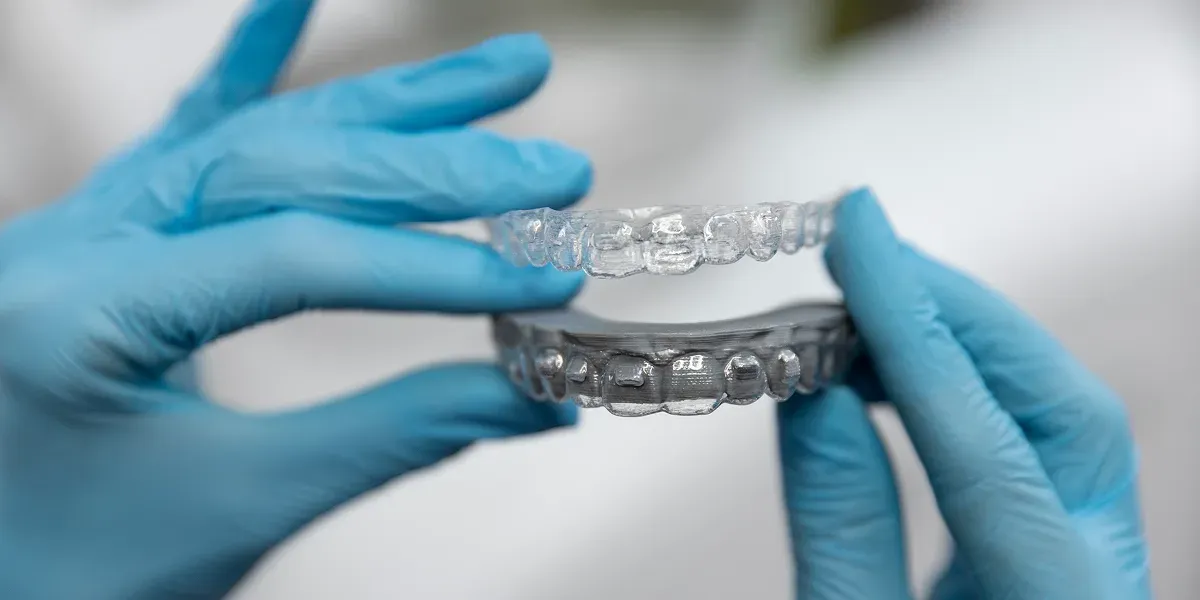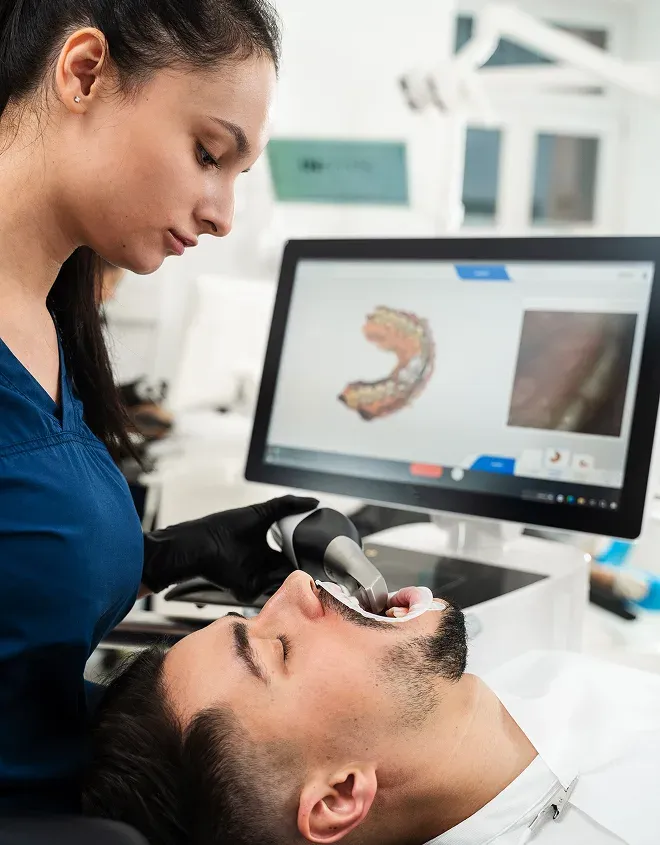The Invisalign Treatment Process: What to Expect Step by Step
by Dr. Labeeb
15 April 2025

If you're thinking about straightening your teeth, Invisalign offers a modern approach that many find practical and effective. Unlike traditional braces, Invisalign uses clear, removable aligners to gradually move your teeth.
One of the most common questions people have is about the process itself. Knowing what to expect from start to finish can help you feel more confident in your decision. This guide breaks down each step of the Invisalign treatment process so you know what to expect and how to prepare.

Step 1: The Initial Consultation
Understanding the Invisalign treatment process starts with your initial consultation. This step is crucial as it sets the foundation for your entire treatment journey. During this stage, your dentist will gather information about your oral health, discuss your goals, and assess whether Invisalign is the right option for you.
Setting Up Your First Appointment
The first step in the Invisalign process is booking a consultation with an Invisalign provider. During this visit, you will discuss your dental concerns and goals. The dentist will evaluate your teeth to see if Invisalign is suitable for your case. This assessment typically includes checking for crowding, gaps, bite issues, and the general condition of your gums and teeth.
Digital Scanning and Imaging
To create a customized treatment plan, the provider will take digital scans of your teeth. These scans give a clear, accurate picture of your dental structure. Unlike traditional impressions, digital scans are more precise and comfortable. The scans are used to map out how your teeth will move over the course of your treatment.
Step 2: Customized Treatment Plan
After the consultation, your dentist will move on to creating your customized treatment plan. This plan is tailored to your specific dental structure and alignment needs. The goal is to develop a series of aligners that will gradually move your teeth into the desired position.

Creating Your Aligners
Once your scans are complete, the dentist will develop a series of aligners tailored to your dental structure. Each set of aligners is slightly different, gradually moving your teeth closer to the desired position. The aligners are made from a durable, clear plastic that fits snugly over your teeth. These aligners are designed to be worn in a specific sequence to ensure steady progress.
Reviewing the Plan
Your dentist will explain the treatment plan in detail, including how long the process is expected to take. You will have a chance to review the digital simulation showing how your teeth will move. This stage is important because it sets expectations for the entire process. You will know how often to change aligners and how long to wear each set.
If you have any concerns or questions about the plan, discuss them before the aligners are made. Being clear about the timeline and expected outcomes helps you stay motivated throughout the treatment.
Step 3: Receiving Your First Set of Aligners
Once your customized aligners are ready, you will receive the first set and detailed instructions on how to use them. Starting your Invisalign journey correctly is important to ensure the best results.
Fitting the Aligners
When your first set of aligners is ready, you will visit the dentist to try them on. The dentist will check the fit and make sure they are comfortable. You will also receive instructions on how to wear and care for them. Aligners should fit snugly but not cause discomfort. A slight pressure is normal as it indicates the aligners are guiding your teeth.
Wearing Guidelines
To get the best results, you should wear your aligners for 20 to 22 hours a day. Only remove them to eat, drink, brush, and floss. Consistent wear is crucial for keeping your treatment on schedule. The more you wear your aligners, the more predictable your results will be.
You may experience mild pressure when wearing a new set of aligners. This is normal and indicates that the aligners are working. Any discomfort usually goes away after a day or two. If you feel persistent pain, contact your dentist to ensure the fit is correct.
Step 4: Adapting to Daily Life with Invisalign
Adjusting to Invisalign takes some time, but most people find the transition smooth. The key is to build a routine that includes proper aligner care and wearing habits.
Eating and Drinking
One advantage of Invisalign is that you can remove the aligners while eating and drinking. Unlike braces, there are no dietary restrictions. However, always brush your teeth before putting the aligners back on to prevent staining and bacteria buildup. This practice helps maintain both the aligners and your oral health.
Snacking frequently can be inconvenient with aligners since you need to clean your teeth each time. Planning meals and reducing snacks can make the process easier. Carrying a small travel toothbrush can also help when eating away from home.
Cleaning Your Aligners
Proper maintenance is important. Rinse your aligners every time you take them out. Brush them gently using a soft toothbrush and mild soap. Avoid using toothpaste, as it can scratch the plastic. Keeping the aligners clean not only prevents staining but also helps maintain oral hygiene.
Avoid eating or drinking anything other than water while wearing your aligners. Foods and beverages can stain or damage the plastic, compromising their clarity and fit.
Managing Discomfort
It is common to feel slight pressure when switching to a new set of aligners. Over-the-counter pain relief can help if needed. Most people find that any discomfort is manageable and fades quickly. Staying consistent with wearing the aligners helps reduce discomfort as your mouth adjusts.
Step 5: Regular Check-Ups and Progress Monitoring
Keeping up with your scheduled visits is essential for tracking your progress and making any necessary adjustments.
Scheduled Visits
During your treatment, you will visit the dentist every 6 to 8 weeks. These appointments are to monitor your progress and make any necessary adjustments. The dentist will check that your teeth are moving as planned and give you the next set of aligners. Missing appointments can delay your progress, so try to stick to your schedule.
Tracking Your Progress
During each visit, the dentist will compare your current alignment with the original plan. If your teeth are not moving as expected, adjustments can be made. Staying consistent with your wear schedule helps keep the treatment on track.
What If an Aligner Breaks?
If an aligner cracks or breaks, contact your dentist immediately. In some cases, you may be advised to wear the previous set until a replacement is made. Never try to fix a broken aligner yourself. Trying to repair it can affect the fit and slow your progress.
Step 6: Completing Your Treatment
The final step of your Invisalign journey is achieving the desired results and maintaining your new smile.
Final Results
Once you have worn your last set of aligners, your dentist will assess your final results. If everything is satisfactory, your active treatment phase is complete. You will likely need to wear a retainer to keep your teeth in place. Retainers help ensure that your teeth do not shift back to their original position.
Retainer Guidelines
Your dentist will explain how often to wear the retainer, usually starting full-time and gradually reducing to nighttime only. Following these guidelines is crucial for long-term success. Neglecting to wear your retainer can lead to teeth shifting, undoing your progress.
Final Thoughts
Choosing Invisalign can help you achieve a straight smile without the inconvenience of metal braces. Understanding the step-by-step process makes it easier to commit to treatment and see it through. Whether you are starting your research or ready to make an appointment, knowing what to expect helps you prepare.
Take the first step towards a confident smile; reach out to us and get started on your Invisalign journey!
Contact your Dentist today at Studio city Dental, to learn more about the Invisalign Treatment Process.
Resource:
Share This:
Disclaimer
*This media/content or any other on this website does not prescribe, recommend, or prevent any treatment or procedure. Therefore, we highly recommend that you get the advice of a qualified dentist or other medical practitioners regarding your specific dental condition. *

